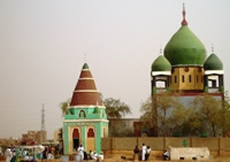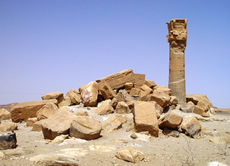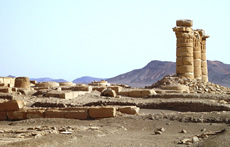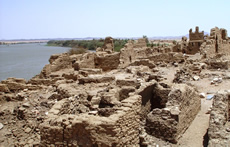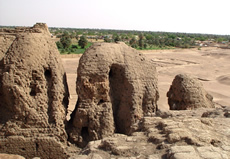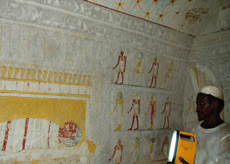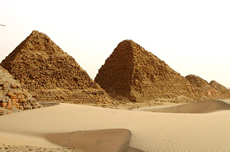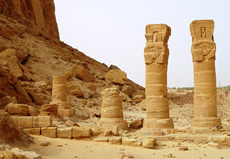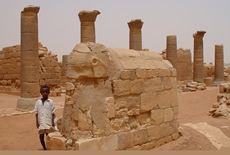|
What to visit in Sudan? Sudan is very rich in itís history as represented in archaeological remains of northern Sudan. Natural scenes of sea, desert, forests and wild life are main assets of Sudanese social life that draw special interest to the vast variety of its ethnic groups with their distinctive culture and folklore . The southern part of the country offers interesting ethnic diversity and a landscape similar to its southern neighbours, while the eastern area at the border to Ethiopia forms a National Park. Currently, however, we do restrict ourselves to operating in the north of Sudan. Following are some features that point out to places of cultural and natural interest
Khartoum - OmdurmanKhartoum, at the confluence of Blue and White Nile, is the modern capital of Sudan. Khartoum itself was built at the turn of this century. One of the most exciting please for a tourist to visit in Khartoum is the Sudanís National museum, the custodian of national historical heritage of Sudanís ancient civilizations. There is also the Ethnographical Museum, which reflects the cultural life and traditional artifacts of the Sudanese people. The Museum of National History sheds light upon the diverse animal life of Sudan. The visitor might as well see Khartoum botanic garden and enjoy the wonders of natural plantations habitat. Itís twin city Omdurman was the Arab trading center and still has colorful African markets worth visiting, as well as the house of the Khalifa and tomb of el Mahdi. The visit to the city of Omdurman, from the other hand, may acquaint the tourist with traditional Sudanese markets and bazaars. It was made capital of the Mahdists who fought English colonizers at the end of the last century and; hence the Mausoleum of the Mahdi and the Khalifa House Museum are main sites of the city. At Omdurman there is a boat yard where traditional boats are made near to the Nile. West of Omdurman almost 40 minutes drive from its center is camels market. Here, camels brought from Western Sudan are offered for sale or barter. Archaeological Sites Sdeinga The temple of Sdeinga was built by Amenophis III. and was dedicated to his wife Tiye. Later finds include a Meroitic cemetery.
Soleb Famous for the ruins of a large temple to Amun-Ra, also by Amenophis III.
Sesebi Here lie the remains of a temple to Amun by Pharaoh Amenophis IV. (Echnaton).
Sai Island The oldest ruins on the island date back to the Kerma period. Sai has been continuously settled and was an important trading post during Pharaonic times.
Kerma The site contains ruins dating back to the earliest culture in Nubia. Within the huge mud brick enclosures lie the remains of temples and burial places
Kawa The site of a temple erected by king Taharqa.
Old Dongola In Christian times it was the capital of the kingdom of Makuria. Most of the area remained Christian until the 15th or 16th century A.D. The fortress of Dongola still overlooks the ruins of an ancient cathedral.
Kurru The site comprises a royal cemetery for the early Napatan kings. The northern plateau houses the tombs of the kings, the southern plateau those of the queens. The most important of these are the tomb of Tanutamani and his mother Kalahata.
Nuri Royal pyramid cemetery of the Napatan kings. The first and largest pyramid dates back to King Taharqa. The nearby oasis of Ghazali still contains the ruins of a Christian monastery.
Karima Located near Jebel Barkal, the little town of Karima is in the proximity of one of the Nile cataracts. Crocodiles may often be watched basking in the sun on sandy islands.
Jebel Barkal The site was the capital of the Napatan kingdom. It comprises six temples, among them the large temple of Amun, several palaces and pyramid cemeteries.
Merowe/Sanam Abu Doma Site of a huge Napatan pyramid cemetery with a temple by King Taharqa.
Meroe/Bajrawija Site of a large Meroitic pyramid cemetery.
Musawwarat es Sufra Another Meroitic site near Nagaa, built into a ravine and protected by high walls from all sides. Main features are a Lion Temple and the Great Enclosure.
Nagaa The Meroitic site is famous for the Lion Temple for the god Apedemak, erected by king Natakamani and queen Amanitere, and a kiosk building of the Roman period similar to the kiosk of Philae island (Aswan, Egypt).
Wadi Bannaga A site on the edge of the flood plain, it served as port for Nagaa and Musawwarat. A palace for queen Amanishakhete, several smaller temples and a cemetery have been found here. thers Selima Oasis This green spot near the northern border with Egypt was a station on the Darb el Arbain, the ďForty Daysí RouteĒ from North Sudan to Aswan, which caravans and camel traders still take. Selima Oasis can be reached by a detour from Soleb/Delgo.
Kordofan North Kordofan offers the opportunity for a camel caravan, riding from Al Obeid to the desert oasis of Al Bashiri and Tawil, 50 kms to the north . The ancient suq of Al Obeid is the first in oil seed and gum Arabic products . South Kordofan offers access to the Eastern side of the Nuba Mountains
Darfur - Jebel Marra - National scenery with birds and baboons - Horse riding and racing - Visit , base of the forty - day road at Melit and follow track for the distance at five miles and back on a camel. - Visit , Fashir ( A mostly desert market ) and obtain hand-made leather artifact woven by nomads - Radom National Game Park ( There are 13 such parks in the republic )
Middle Region The so-called ďGeziraĒ has the largest irrigation scheme in Africa.
Eastern Region - Kassala The area at the Upper Setit River ( on the Atbara reach ) is wild, but full of different types of game . Lions are daily expected in this area but the trip needs special arrangement and a security permission. Different species of migratory birds in great numbers frequent hafirs of the Butana and remain put for days. This is seasonal and selection of sports for that purpose needs careful planning.
Dinder National Park The Dinder Protected Area is situated south-east of Khartoum at the Ethiopian border. The woodland, lakes and plains of the park offer an opportunity to do bird watching and see African fauna like buffalos, antelopes, wart hogs and even larger predatory animals like lions. Accommodation is at a park lodge. A 2-3 days tour is recommended.
The Red Sea Coast The Sudanese Red Sea Coast is still largely undeveloped and therefore a diverís paradise. Coastal lagoons (mersa) and coral reefs (shaab) harbor an abundance of maritime life. The mersas may be protected by fringing reefs or may cut into the coastal plain. Despite the heavy influx of fresh water during the rainy season, corals grow fro centimeters to tens of meters. The fringing reefs or shaab are usually about 1000 meters wide but may extend three times as wide. Besides, there are atolls offshore surrounded by water several hundreds of meters deep. All types of reefs offer shallow areas suitable for snorkeling. Diving safaris can be arranged from Port Sudan.
Suakin The ghost island of Suakin was Sudanís major port until the founding of Port Sudan. The corals that form Suakiní s harbor finally grew so as to close the island off for the ships. The buildings of the abandoned settlement on the island are all erected of blocks hewn from corals. |
|
|
Tomb of el Mahdi |
|
|
|
|
|
Sdeinga Temple |
|
|
|
|
|
Temple of Soleb |
|
|
|
|
|
Temple of Sesebi |
|
|
|
|
|
Island of Sai |
|
|
|
|
|
Kerma Deffufa |
|
|
|
|
|
Old Dongola |
|
|
|
|
|
El Kurru |
|
|
|
|
|
Nuri Pyramids |
|
|
|
|
|
Gebel Barkal |
|
|
|
|
|
Meroe Pyramids |
|
|
|
|
|
Temple of Musawwarat |
|
|
|
|
|
Temple of Naga |
